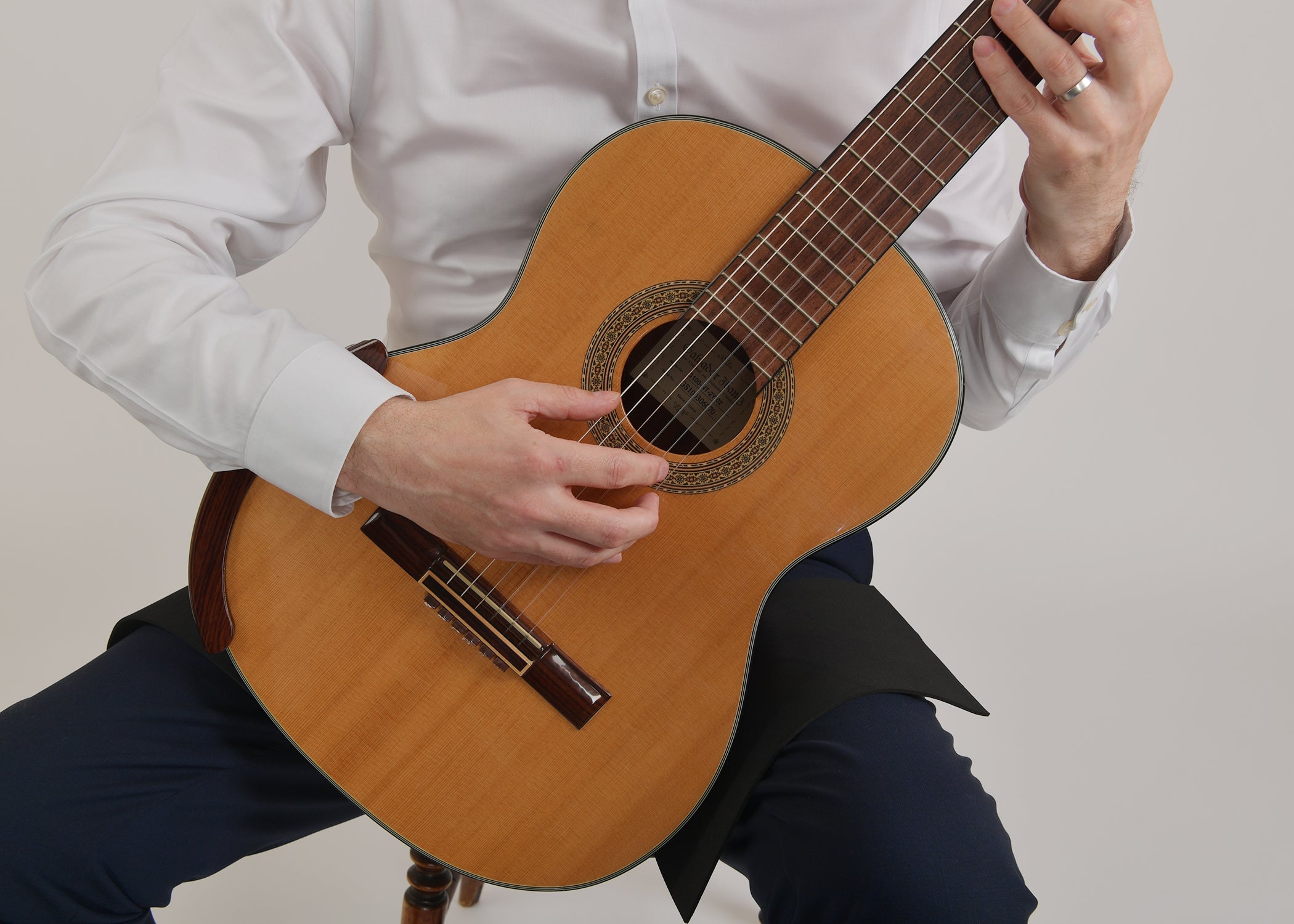Hello and welcome. Today, we are in the Koivisto guitar workshop with Sami, discussing the differences between double-top and traditional-top classical guitars(referred to here as single or solid-top guitars). Sami has been our favourite Glasgow-based luthier for the past few years.
First, Let’s Delve into the Birth of Double-Top Classical Guitars
In the early 1990s, German luthiers Matthias Dammann and Gernot Wagner revolutionized classical guitar making with the introduction of the double top guitar, also known as the “Sandwich Top.”
They aimed to address challenges faced by concert guitarists, such as insufficient volume and projection in large venues, by experimenting with a layered soundboard design.
This innovation involved two thin outer layers of wood (typically spruce or cedar) with a lightweight core material like Nomex in between. The result was a lighter yet stronger soundboard that offered greater efficiency in vibration, producing more volume and sustain without compromising tonal quality.
Read Also: Classical Guitar Armrest: Comfort, Protection, and Superior Sound
This design was embraced by concert guitarists who needed their instrument to stand out in large venues, and it has since become a favourite for many modern players.
Meanwhile, single-top guitars, with their traditional construction of a single solid piece of tonewood, remain a timeless choice for their warm and natural sound. In this post, we’ll explore the key differences between double top and single top guitars, their impact on tone, and why players might choose one over the other.
Afternoon Sami, I’m glad to be in your workshop again, although sadly, I bring an instrument with a broken bridge (PS. I got the instrument back with a repaired bridge 2-3 days later, and I can’t tell if it is the same bridge or a new one, it is repaired so well).
But we got into this conversation about double top guitars last time I was here, and what a great opportunity to finish our last conversation. I’ve got a question, though. If double top guitars are so good, why do players still order single top guitars?
Sami:
Hi Pete, it is good to see you again. Well, single-top guitars are constructed using a single solid piece of tonewood, such as European spruce or Western red cedar, for the soundboard.
This has been the standard method for centuries, forming the backbone of classical guitar construction. The soundboard is typically reinforced with internal bracing, such as fan or lattice bracing, to balance strength and tonal characteristics.
Solid top soundboards tend to be slightly heavier than double tops. Double top guitars feature a laminated soundboard composed of two thin outer layers of tonewood with a core material like Nomex or balsa. This “sandwich” design allows for a thinner, lighter soundboard that is still rigid enough to withstand the tension of the strings. Double tops do still require bracing, too.
Read Also: How Plastic Guitar Beads Improve Classical Guitar’s Sound
Alba GB:
Ah, I see. That is why single tops are celebrated for their traditional and warm tonal qualities. I read a few articles about double tops, but it seems players still prefer single top guitars as well, as they offer a complex tonal palette with rich harmonic overtones and subtle dynamic gradations.
The natural decay of notes on a single top is gradual and full-bodied, lending itself to expressive phrasing and intricate musicality.
However, their projection may be limited in larger concert halls, making them more suited to intimate settings or recording environments. Cedar single tops, for example, are known for their warm, dark tones and are ideal for Romantic-era repertoire like Francisco Tárrega’s works.
Spruce single tops, in contrast, provide a brighter and more articulate sound, making them well-suited for Baroque music, such as Johann Sebastian Bach’s lute suites.
Read Also: Evolution of Classical Guitar Supports: Innovation & Choosing the Right Support
Double tops, by comparison, are designed for power and projection. Their tone is characterized by clarity, volume, and sustain. Each note stands out with sharp articulation, making them ideal for fast, complex passages.
They excel in dynamic consistency, maintaining tonal integrity even at high volumes. A double top’s brighter, punchier sound makes it particularly effective for modern repertoire with percussive elements, such as Leo Brouwer’s compositions.
They are also a favourite for ensemble playing, where clarity and projection are essential to cutting through other instruments.
Sami:
Well Pete, I guess the answer is somewhere between yes and no. I would avoid associating any stereotypical sound characteristic differences between solid top guitars vs double top guitars or even between wood species, for example, spruce vs cedar, as guitars are unique and there are a lot of factors in play when you’re building a guitar.
Read Also: Plastic Guitar Beads vs Metal Guitar Beads
It is true that double tops can be built lighter than solid tops, which can have the advantage if you’re trying to achieve a more responsive guitar. In many cases, double top guitars are louder, but it all depends on how good a luthier is and how he wants his guitar to project tonally. Nothing is carved in stone here.
Alba GB:
Great clarification. But the million-dollar question is, how well do double top and single top guitars perform over time? And how often do single and double-top guitars come through your door for repairs and maintenance?
Sami:
When it comes to durability and aging, solid tops often improve over time. As the wood matures, the tonal richness deepens, and the guitar becomes more responsive. They are also easier to maintain and repair due to their simpler construction.
Double tops, while durable, may not age as dramatically as solid tops because of their laminate construction and often used composite materials. Repairs to double tops can be more complex and may require specialized skills.
I see both types of guitars coming in for repairs and maintenance for various reasons. It is the nature of the beast.
Read Also: Carbon Case for Classical Guitar: Style, Protection and Comfort for Musicians on the Go
Alba GB:
What would you advise an owner of a double top and single top guitar not to do to their instrument?
Sami:
Well, there are not many specifics, and I would advise the same as I would for any classical and flamenco guitar:
1. Do Not Expose the Guitar to Extreme Temperature or Humidity Fluctuations
Why: Both double-top and solid-top guitars are sensitive to environmental changes. Excessive heat, cold, dryness, or humidity can cause the wood to warp, crack, or delaminate.
- Specific Concern for Double Tops: The lightweight core material in a double top, such as Nomex, can be more susceptible to delamination or bonding, but overall, they seem to be better at handling environmental changes than solid tops.
- Specific Concern for Solid Tops: Single tops, being made of a solid piece of wood, are prone to cracking or excessive shrinking in overly dry conditions. These cracks can compromise the tone and structural integrity of the guitar and need to be repaired as soon as possible.
- Recommendation: Use a case with a humidity control and/or a meter, and keep the guitar in a stable environment (45–55% humidity) and don’t expose it to intensive cold or heat.
Alba GB:
Hmm Hmm … Alba GB carbon guitar cases do a phenomenal job at protecting the guitars while keeping the humidity and temperature at the desired levels.
Read Also: Metal Guitar Beads: Better Tone, Sustain, and Playability
2. Do Not Apply Excessive Pressure to the Soundboard
Why: The soundboard is the heart of the guitar’s tone production. Applying pressure, whether from leaning objects against it, pressing too hard during cleaning, or improperly storing the guitar, can weaken the structure or cause dents.

- Specific Concern for Double Tops: The thinner outer layers of wood on a double top are more vulnerable to damage from pressure.
- Specific Concern for Solid Tops: While single tops are generally thicker, they are not immune to dents and scratches that can alter vibration patterns and affect tone.
-
Recommendation: Always handle the guitar with care and store it in a hard case when not in use.
Read Also: Arm Sleeves: A Deeper Look into Their History, Purpose, and Professional Use
3. Do Not Neglect Regular Cleaning and Maintenance
Why: Dirt, sweat, and grime can accumulate over time, dulling the finish and potentially affecting the wood. Neglecting maintenance can also lead to buildup around the frets, bridge, and sound hole, impacting playability and tone. Improper cleaning methods, such as using harsh chemicals, can damage the finish or dry out the wood.
- Keep in mind that the French-polished guitars are more fragile than lacquered ones, so they need to be handled more carefully. And remember not to mess with hard liquors around it, as alcohol will burn through shellac. J
- Recommendation: Use a microfiber cloth to gently wipe down the guitar after each use, especially the soundboard. Avoid harsh cleaners and, instead, use guitar-specific cleaning solutions.
Alba GB:
Brilliant, these are some important care steps. And finally, Double top flamenco guitars – is there such a beast? I have not seen any.
Read Also: How Important Is Nail Care for Classical Guitarists?
Sami:
Yes, double top flamenco guitars do exist, though they are less common than double top classical guitars. The reason for their relative rarity lies in the specific tonal and structural requirements of flamenco guitars, which differ from classical guitars.
Flamenco techniques involve hitting the top with fingers. The top is protected by a golpeador, a tap plate. There has been a concern that, over time, flamenco techniques would delaminate or make dents in the double top.
However, I haven’t yet seen that happen. Using a thick enough and a bit larger golpeador would remedy that. Some luthiers have successfully adapted the double top concept to meet the needs of flamenco players.
Despite these challenges, double-top flamenco guitars could have some potential advantages, for example, increased volume and stability during environmental changes.
Alba GB:
Wow, thanks for that. I would not have thought about it. Thanks very much for the chat and for agreeing to share your wisdom with us.
For our followers, please check our next blog post when we will chat to Sami about classical guitar maintenance and what to do yourself, and when to see a luthier.
Sami:
You are welcome. It is always a pleasure to chat to you, Pete. See you next time.
Let’s Summarise:
Is a Double Top More Suitable for You Than a Single Top?
Ultimately, the choice between a double top and a single top guitar depends on the player’s preferences, repertoire, and playing environment. Testing both types of guitars is essential to determine which construction best aligns with your musical goals.
Single tops are ideal for players seeking warmth, complexity, and a traditional feel, while double tops cater to those who prioritize projection, clarity, and modern tonal characteristics.
Both types of guitars offer unique strengths and can complement different aspects of a guitarist’s performance, making the decision a deeply personal one. If you’re a flamenco player curious about double tops, it’s essential to test one made specifically for flamenco.
The luthier’s experience and approach to balancing the unique requirements of flamenco music with the advantages of double top construction will make a significant difference.
Keep in mind that the tonal and structural qualities of traditional flamenco guitars might be better suited to purists, while a double-top flamenco guitar could appeal to players seeking a modern twist or enhanced versatility. See you next time!





Leave a comment
This site is protected by hCaptcha and the hCaptcha Privacy Policy and Terms of Service apply.